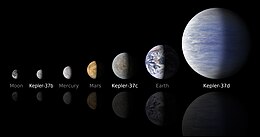| Observation data Epoch J2000 Equinox J2000 | |
|---|---|
| Constellation | Lyra |
| Right ascension | 18h 56m 14.30760s[1] |
| Declination | +44° 31′ 05.3896″[1] |
| Apparent magnitude (V) | 9.710[2] |
| Characteristics | |
| Spectral type | G8V |
| Astrometry | |
| Radial velocity (Rv) | −30.92±0.20[1] km/s |
| Proper motion (μ) | RA: −60.396 mas/yr[1] Dec.: 48.657 mas/yr[1] |
| Parallax (π) | 15.6253 ± 0.0105 mas[1] |
| Distance | 208.7 ± 0.1 ly (64.00 ± 0.04 pc) |
| Details | |
| Mass | 0.79+0.033 −0.03[3] M☉ |
| Radius | 0.789+0.0064 −0.0056[3] R☉ |
| Temperature | 5357±68[3] K |
| Metallicity [Fe/H] | −0.36±0.05[3] dex |
| Rotational velocity (v sin i) | 1.1 (± 1.1)[4] km/s |
| Age | 7.6+3.4 −3.1[3] Gyr |
| Other designations | |
| Database references | |
| SIMBAD | data |
| KIC | data |
Kepler-37, also known as UGA-1785,[6][7][8] is a G-type main-sequence star located in the constellation Lyra 209 light-years (64 parsecs) from Earth. It is host to exoplanets Kepler-37b, Kepler-37c, Kepler-37d and possibly Kepler-37e, all of which orbit very close to it. Kepler-37 has a mass about 80.3 percent of the Sun's and a radius about 77 percent as large.[4] It has a temperature similar to that of the Sun, but a bit cooler at 5,357 K. It has about half the metallicity of the Sun. With an age of roughly 6 billion years,[9] it is slightly older than the Sun, but is still a main-sequence star. Until January 2015, Kepler-37 was the smallest star to be measured via asteroseismology.[10]
- ^ a b c d e Cite error: The named reference
GaiaDR3was invoked but never defined (see the help page). - ^ a b "Kepler Host Star Characteristics". Archive for Space Telescopes. STSI. 2012-02-24. Retrieved 2013-02-21.
- ^ a b c d e Cite error: The named reference
Bonomo2023was invoked but never defined (see the help page). - ^ a b Cite error: The named reference
Naturewas invoked but never defined (see the help page). - ^ Cite error: The named reference
Simbadwas invoked but never defined (see the help page). - ^ Planets in Kepler-37 star system designated ‘UGA-1785’ by NASA
- ^ 211 light years away, star system named for UGA
- ^ Kepler-37, Open Exoplanet catalogue
- ^ Smallest Alien Planet Kepler-37b Explained (Infographic)
- ^ Cite error: The named reference
NASAwas invoked but never defined (see the help page).
